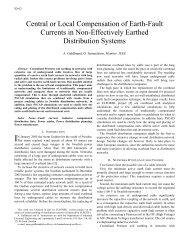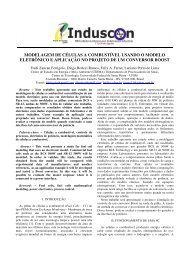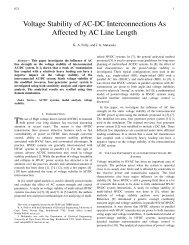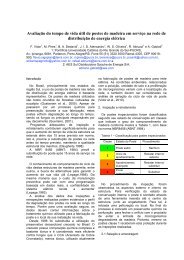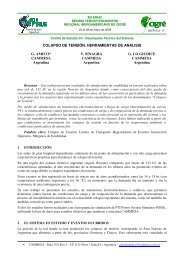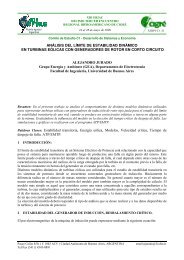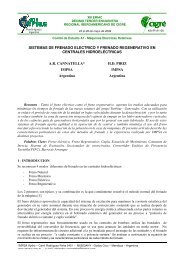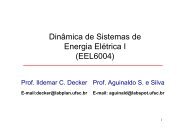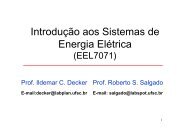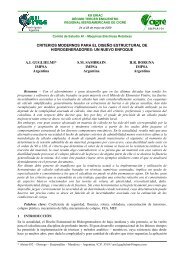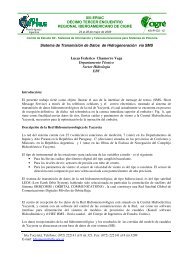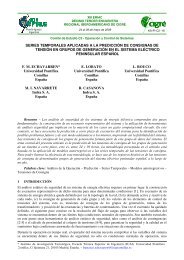Earth Return Path Impedances of Underground Cables for ... - LabPlan
Earth Return Path Impedances of Underground Cables for ... - LabPlan
Earth Return Path Impedances of Underground Cables for ... - LabPlan
Create successful ePaper yourself
Turn your PDF publications into a flip-book with our unique Google optimized e-Paper software.
J<br />
z<br />
= Jez + Jsz<br />
(12)<br />
where J<br />
ez<br />
is the eddy current density and J sz<br />
the source<br />
current density, given by (13) and (14) respectively.<br />
J =− jωσ<br />
A<br />
(13)<br />
ez<br />
J<br />
sz<br />
z<br />
=−σ∇Φ (14)<br />
FEM is applied <strong>for</strong> the solution <strong>of</strong> (9) and (10) with the<br />
boundary conditions <strong>of</strong> (11). Values <strong>for</strong> J on each<br />
conductor i <strong>of</strong> conductivity σ<br />
i<br />
are then obtained and equation<br />
(8) takes the <strong>for</strong>m<br />
V J<br />
sz<br />
σ<br />
i<br />
i i<br />
Zij<br />
= = ( i, j = 1, 2, …, n)<br />
(15)<br />
I I<br />
j<br />
j<br />
linking properly electromagnetic field variables and<br />
equivalent circuit parameters.<br />
A distinct advantage <strong>of</strong> the FEM is its capability <strong>of</strong><br />
handling cases <strong>of</strong> geometrical or electromagnetic ground<br />
irregularities <strong>of</strong> almost any kind, where conventional methods<br />
fail.<br />
V. NUMERICAL RESULTS<br />
The proposed numerical integration scheme was applied in<br />
the following cases <strong>of</strong> SC cable arrangements in homogeneous<br />
ground.<br />
First the case <strong>of</strong> a shallowly located SC cable system <strong>of</strong><br />
Fig. 2 was examined [12] in a horizontal (a) and a vertical (b)<br />
cable arrangement. Cable is in a depth h=1,2 m with a spacing<br />
−3<br />
s=0,25m. The core radius is = 23,4 ∗10<br />
m, while the outer<br />
radius is<br />
r S<br />
= 48,4 ∗10<br />
−3<br />
sz i<br />
m. The conductance <strong>of</strong> the cable core<br />
is σ = 5, 88235∗10 7 S/m and µ = 1 <strong>for</strong> the ground.<br />
r C<br />
r<br />
air<br />
earth<br />
h r c<br />
r c r c<br />
h<br />
r c<br />
air<br />
earth<br />
compared to the corresponding obtained by EMTP and FEM<br />
<strong>for</strong> earth resistivities from 2 Ωm up to 1000 Ωm and <strong>for</strong> a<br />
frequency range <strong>of</strong> 1 Hz to 10 MHz. For each case the relative<br />
differences <strong>of</strong> the <strong>for</strong>m <strong>of</strong> (16) were calculated<br />
ZNum<br />
− ZEMTP<br />
Relative difference (%) = ∗ 100 (16)<br />
Z<br />
EMTP<br />
In Fig. 3 the relative differences <strong>for</strong> the magnitude <strong>of</strong> the<br />
self impedance <strong>of</strong> the horizontal cable arrangement <strong>of</strong> Fig. 2<br />
are shown. Differences up to 12% occur, especially <strong>for</strong> low<br />
earth resistivities and high frequencies.<br />
difference(%)<br />
40%<br />
30%<br />
20%<br />
10%<br />
ρ=2 Ωm ρ=10 Ωm<br />
ρ=50 Ωm ρ=100 Ωm<br />
ρ=200 Ωm ρ=300 Ωm<br />
ρ=500 Ωm ρ=1000 Ωm<br />
0%<br />
1,E+00 1,E+01 1,E+02 1,E+03 1,E+04 1,E+05 1,E+06 1,E+07<br />
frequency(Hz)<br />
Fig. 3: Differences in Z 11 between numerical integration and EMTP.<br />
In Fig. 4 the corresponding differences <strong>for</strong> the magnitude<br />
<strong>of</strong> the mutual impedance <strong>of</strong> the cable arrangement are shown.<br />
The differences in this case are due only to the different<br />
approaches in earth return impedance calculation and are<br />
higher reaching up to 25%.<br />
difference(%)<br />
40%<br />
30%<br />
20%<br />
10%<br />
ρ=2 Ωm ρ=10 Ωm<br />
ρ=50 Ωm ρ=100 Ωm<br />
ρ=200 Ωm ρ=300 Ωm<br />
ρ=500 Ωm ρ=1000 Ωm<br />
r s<br />
r s<br />
r s<br />
s<br />
a<br />
s<br />
Fig. 2: Horizontal (a) and vertical (b) SC cable arrangements in homogeneous<br />
ground.<br />
Series impedances were calculated <strong>for</strong> this configuration<br />
using the proposed integration scheme and they were<br />
s<br />
s<br />
b<br />
r s<br />
r c<br />
r c<br />
r s<br />
r s<br />
0%<br />
1,E+00 1,E+01 1,E+02 1,E+03 1,E+04 1,E+05 1,E+06 1,E+07<br />
frequency(Hz)<br />
Fig. 4: Differences in Z 12 between numerical integration and EMTP.<br />
Next the case <strong>of</strong> a SC core cable with core and sheath, as in<br />
Fig. 5 is considered. Original cable data from [3] are<br />
reproduced in Table I. The cable arrangements are similar to<br />
those in Fig. 1 with h=0,75m, s=0,15m and µ<br />
r<br />
= 1 <strong>for</strong> both<br />
media.<br />
The differences <strong>of</strong> (16) were calculated <strong>for</strong> the above cable<br />
arrangement using the previous earth resistivities and<br />
frequencies. In Fig. 6 and Fig. 7 these differences are shown<br />
<strong>for</strong> the case <strong>of</strong> vertical configuration, <strong>for</strong> the real and the<br />
imaginary parts <strong>of</strong> the mutual impedance between the cable



